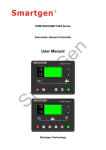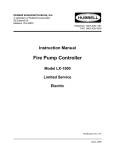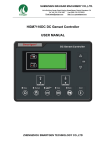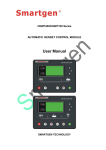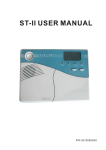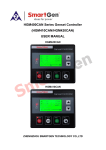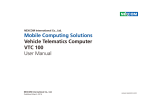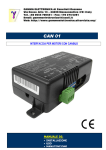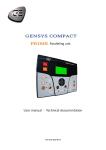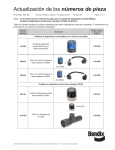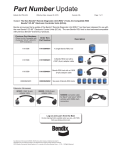Download View the SMX ED
Transcript
SMX ED-4 DIGITAL DISPLAY USER’S GUIDE ED-4 Display Installation 1. 2. 3. 4. 5. 6. 7. Decide on a location. Allow adequate clearance behind the unit for the cable connection to ensure the cable is not unduly stressed. Ensure that there is sufficient length of cable to remove unit for servicing purposes. Using the supplied template as a guide, cut out the hole for the back and drill four 4.3 mm (0.170”) holes for the studs. Screw the four M4 studs into the rear of the unit. Connect the cable into the rear of the unit. Place the unit in position, then secure it by screwing the thumb nuts onto the studs. Power On Screen This power on screen will be shown when power is first applied to the unit. The display will perform a self-test for proper operation of the datalink, flash, RAM and LCD. A progress bar gives a general indication of how far the self-test has progressed. The display also indicates the current user for whom the display is configured. Engine Configuration, Comms Protocol and Engine source Software Version Shows the current user for whom the display is configured Bar indicating how far the self-test has progressed Parameters tested by the display Initial Setup On initial power up the display will automatically enter screens within the Settings and Config Menus which need to be set up by the user in order to use the display. Once these are set on the initial power-up, it is not necessary to repeat these steps. If the initial settings have been set incorrectly, the setup screens can be corrected via the Configuration Menu (see Configuration Menu section). The user is first prompted to select the engine model to which the display is connected. Key 1 Key 2 Key 3 Key 4 The display then enters the Data-link screen and the user should select Data type, either J1587 or J1939. Key 5 Use up/down scroll keys (Key 1 or Key 2) to move the pointer to the desired engine model. Press the SELECT key (Key 4) to fill in the box in the right hand column adjacent to the desired model, then press the BACK key (Key 5). Use the up/down scroll keys (keys 1 and 2) to move the pointer to the data type item followed by the ADJ key (key 4) to select between J1939 and J1587 Data type. Default Screen (BASIC PAGE) The BASIC PAGE is displayed after the power on screen is finished testing the functionality of the unit. The “SYSTEM OK” banner is displayed for the first 60 seconds, then turned off. The “ACTIVE FAULT PRESENT” banner is only displayed if certain ECM (Engine Control Module) fault codes are active. The Electronic Display does NOT show all possible ECM fault codes at this time. “SYSTEM OK” banner displayed upon power up and turns off after 60 seconds “ACTIVE FAULT PRESENT” banner is displayed if a fault code becomes active. “DATA LINK INACTIVE” banner displayed when no engine data is available Key 1 Key 2 Key 3 Key 4 Key 5 If no keys are pressed within 5 seconds, the button bar will slide down out of view and reveal engine feature switches that are turned on (if this feature is supported by the installation). Engine Feature switch indication. Only available with certain engines and data types Pressing keys 1 to 4 will restore the menu button bar to the screen, whereas pressing key 5 will allow the user to set lighting and contrast values (see Lighting and Contrast section). Changing the engine parameter to be viewed To select an alternate engine parameter to be viewed, press the ADJUST key (Key 4) PRESS KEY 4 then Press the Up or Down arrow key to select the engine parameter to be changed. This will place a box around the selected parameter. Press the ADJUST key (Key 4) to scroll through the viewableengine parameters to the one desired. Only the parameters supported by a particular engine model will be available for selection. Press the BACK key when done making changes. NOTE: The list of parameters shown below may not be fully supported by the engine model selected. Select engine parameters by pressing the ADJUST key (Note: below is a list of typical parameters that are available. Only parameters supported by the engine model selected will be available for viewing). Display ENGINE SPEED Display COOLANT TEMPERATURE Display ENGINE OIL PRESSURE Display SYSTEM VOLTAGE Display INSTANTANEOUS FUEL RATE Display ENGINE LOAD Display INTAKE MANIFOLD TEMPERATURE *The boat speed input is optional and must be set up separately. See the appendix for details. Display BOOST PRESSURE Display THROTTLE POSITION Display BAROMETRIC PRESSURE Display SPEED (BOAT SPEED)* Navigation between pages Three different groups of pages are available .VIEW (Key 1) .TRIP (Key 2) .DISP (Key 3) Pressing one of these keys will display a pop-up window. Pressing the same key again will select the next item in the list. Press GO (Key 4) to display the selected page. Press ABORT to cancel the navigation and go back to the last displayed page. If no keys are pressed within 5 seconds, the pop-up window will disappear and the selected page will be displayed. View group (VIEW – Key 1) This group allows the display of available data in different formats. As in the BASIC PAGE, pressing Key 4 can configure each view. Boat speed can be displayed only if GPS or a speed transducer is connected on the RS422 input. Navigate with Key 1 Press Key 4 BASIC PAGE Pressing1 or Key 2 will select the parameter to be changed. Press Key 4 until the desired engine parameter is displayed. Press BACK when done. QUAD GAUGE Press Key 4 QUAD TEXT Pressing Keys 1-4 will change the engine parameter in the quadrant selected. Press BACK when done. BI TEXT Press Key 4 Pressing Keys 1-2 will change the engine parameter. Press BACK when done. Trip Group (TRIP – Key 2) This group allows the display of data related to the current trip. TOTAL TRIP and STATISTICS are not affected by turning the engine off. Data in these screens continues to accumulate until cleared with the RESET key. NOTE: Using the RESET key on either the TOTAL TRIP or STATISTICS screen will clear data from memory on both screens. Navigate with Key 2 TOTAL TRIP Press Key 4 Press and hold Key 4 for one second which will reset the trip data and statistics and will restart the trip hours and fuel display data. Press Key 4 SPEED GRAPH* The graph represents the boat speed plotted against engine speed. Press and hold Key 1 for one second which will clear the graph. Press and hold Key 2 for one second which will store the graph in non-volatile memory. Press Key 4 STATISTICS Press and hold Key 4 for one second to reset the trip data and statistics and to restart the trip hours and fuel display data. *The boat speed input is optional and must be set up separately. See the appendix for details. Display Group (DISP – Key 3) Press Key 3 Display ENGINE SPEED Press Key 4 GRAPH FORMAT Display COOLANT TEMPERATURE BIG FORMAT Display ENGINE OIL PRESSURE GAUGE FORMAT Display SYSTEM VOLTAGE Display INSTANTANEOUS FUEL RATE Display ENGINE LOAD Display INTAKE MANIFOLD TEMPERATURE Display BOOST PRESSURE This group allows selection of a single engine parameter to be viewed (Note: below is a list of typical parameters that are available. Only parameters supported by the engine model selected will be available for viewing). Pressing Key 4 will select viewable engine parameters in various formats. Display THROTTLE POSITION Display BAROMETRIC PRESSURE Display CRANKCASE BLOWBY PRESSURE Display SPEED (BOAT SPEED)* *The boat speed input is optional and must be set up separately. See the appendix for details. Alarm Page (Key 5) When an alarm is present, the display will bleep and the “Active Fault Present” banner will flash over the screen on every page. While in BASIC PAGE, parameters related to active faults will flash. The display will detect selected faults depending on the engine application. The fault condition must be corrected and each individual fault must be cleared in the ALARM PAGE to remove the flashing banner. Refer to the appendix for a list of faults for each engine application. NOTE: There is an external alarm driver available from the Electronic Display. Refer to the wiring diagram in the appendix for information. Alarm will stay active until fault condition is eliminated Banners will flash and beeper will sound during an active alarm Press Key 5 to go to ALARM PAGE On every page, a bell icon is displayed on Key 5. Press Key 5 to select the ALARM PAGE where the bleep can be turned off and the alarm text information can be read. The ALARM PAGE is a pop-up window that displays the list of all current active faults. Alarms are listed in reverse chronological order. The most recent alarm will be shown at the top of the list. Pressing key 3 will silence the alarm until a new alarm becomes active. Key 1 and Key 2 are used to navigate through the list of active faults. Press Key 4 to read the text information associated with the selected fault. Press Key 3 to stop the beeper Fault description Press Key 4 to read text information of selected alarm When giving infor mation to Cummins, use this fault code number When active fault information is displayed, the fault can be cleared by pressing Key 3. The fault will then be removed from the list. Key 1 and Key 2 can still be used to navigate through active faults. Press Key 4 to go back to the fault list. Press Key 3 to clear this fault and remove it from the list Press Key 5 to go back to the background screen. Menu Exit (MENU EXIT – Key 5) When no active faults are present, this key allows clearing of the menu bar from the screen as well as adjusting display contrast and backlighting. Under normal conditions, the menu bar will remain present at the bottom of- the display for 5 seconds and then will slowly slide to the bottom until it disappears. Pressing Key 5 will im mediately hide the menu bar. Pressing any key except Key 5 will then restore the menu bar. Lighting and Contrast Pressing Key 5 while the menu bar is hidden will display the lighting and contrast controls. Decrease/Increase the contrast Decrease/Increase the lighting brightness Press Key 5 to exit when done Contrast Reset If the display contrast has been set so that the display is unreadable and can not be ad justed back, press the first four keys together. This will reset the contrast to a central value and reset the lighting to maximum. Note: The key press bleep will also be turned on. Configuration Menu Pressing and holding down Key 5 for 3 seconds will display the configuration menu. PRESS and HOLD KEY 5 then Press Up or Down arrow key to select the display configuration to be charged. This will place a “>” next to the selected item. Press the ADJUST key (Key 4) to enter the SETTING MENU screen to make the desired changes. Press the EXIT key when done. User Menu Six user setups can be stored in this menu with an associated user name. The user can configure the screens with the desired parameters then store the setup here. The selected user’s name will be shown on the startup screen when the unit is first turned on. Setting Menu Allows changing the following: LANGUAGE BLEEP UNITS DAMPING Configurable ON/OFF ENGLISH/METRIC 0-100% (How fast the data is updated on the screen) ALARM ON/OFF (Basic Page will show SPEED GPS to indicate alarm is off.) Caution: Turning the alarm off will prevent the display from showing any active faults. Use this function only when the Engine Data Display is not used at the helm. ON/OFF Boat speed value can be received from either a GPS (speed over ground) or a speed transducer (speed over water). This feature is for the Marine application only. See the appendix for required wiring connections. Alarm History Provides engine snapshot data that was captured with the 5 most recent engine fault codes. These fault codes cannot be cleared by the user. System Menu Note: This menu was designed for use by Cummins service personnel. Incorrect use of these features can cause problematic operation. DEMO Turns the display demo mode on or off. This mode is not intended for normal usage. RESET ALL Resets the Engine Data Display module to the factory default settings. UPLOAD Allows the unit to be reprogrammed when selected. ABOUT Summarizes display running mode information. DATALINK Menu ENGINE DATA TYPE DATA LINK INFO (when Data Type is J1587) J1939 SETTINGS (when Data Type is J1939) DATA LINK INFO (when Data Type is J1939) Selects the engine model that is connected to the display. Choices include QSB, QSC, QSM11, 480C-E Use the ADJUST key (key 4) to enter the Setting Menu then use up/down scroll keys (keys 1 and 2) to move the pointer to the desired engine model. Press the SELECT key (key 4) to fill in the box in the right hand column adjacent to the desired model, then press the BACK key (key 5) to return to the Datalink Menu. Selects Data type (J1939 or J1587). Use the ADJUST key (key 4) to desired setting. J1587 INFO Allows user to view J1587 message data J1587 VIEWER Allows user to view J1587 raw messages received by the Display. NMEA VIEWER Allows user to view NMEA raw messages received by the Display. Use the ADJUST key (key 4) to enter the Data Link Info screen. Use the up/down scroll keys (keys 1 and 2) to move the pointer to the desired selection followed by the ADJUST key (key 4) to enter the screen and view the data. Use the BACK key (key 5) to return to the Data Link Info menu. Allows user to configure engine source to suit the configuration of the installation. Choices include 1 (Actual SA 00), 2 (Actual SA 01), 3 (Actual SA 242), 4 (Actual SA 243), 5 (Actual SA 244) and 6 (Actual SA 245). Use the ADJUST key (Key 4) to enter the J1939 Settings screen. Use the ADJUST key (Key 4) to select the desired setting, press the BACK key (Key 5) to return to the Data- Link Menu. J1939 VIEWER Allows user to view J1939 raw messages received by the Display. NMEA VIEWER Allows user to view NMEA raw messages received by the Display. Use the ADJUST key (key 4) to enter the Data Link Info screen. Use the up/down scroll keys (keys 1 and 2) to move the pointer to the desired selection followed by the ADJUST key (key 4) to enter the screen and view the data. Use the BACK key (key 5) to return to the Data Link Info menu. RPM Menu Allows the user to select rounding of the RPM value. Choices are rounding to the nearest 10’s, nearest 5’s, or nearest 1’s. The default value is set to the nearest 10’s. Values are changed using the ADJUST key. APPENDIX Electronic Display Connections When using SAEJ1708/ J1587 communication protocol the display requires four wires to operate: two for power and two for the SAE J1587 databus. Pin assignments are shown below. When using SAEJ1939 communication protocol, again the display requires four wires to operate: two for power and two for the J1939 databus. However the SAEJ1939 databus connections are different to those of the SAEJ1587 databus. Pin assignments are shown below: Vehicle speed input from a GPS or speed transducer can be input to the display. 15. GEMpinconnection Connector out Signal data Notes - continued Connector pin out 1 Signal 12 Ground 23 NMEA TX (+) Keyswitch 34 NMEATX TX(-)(+) NMEA 45 NMEARX TX(-)(-) NMEA 5 6 7 8 Notes Keyswitch Ground NMEA RX (-) 6 NMEA RX (+) 7 CAN LO (J1939 LO) 8 CAN HI (J1939 HI) NMEA RX (+) CAN LO CAN HI 99 J1708/J1587+ J1708/J1587 + 10 10 J1708/J1587J1708/J1587 - 11 11 External Alarm Output External Alarm Output 12 12 NotUsed Used Not Note that pin 11 of the connector can be used to drive an external alarm. To do this, wire a switched +12 volt supply wire to one side of the alarm, and the other to pin 11 of the connector from the display. The external alarm will activate whenever the display alarm bleeps.












